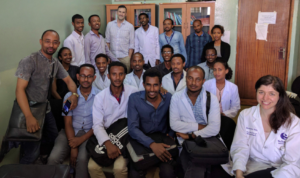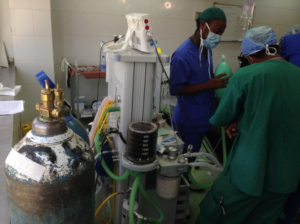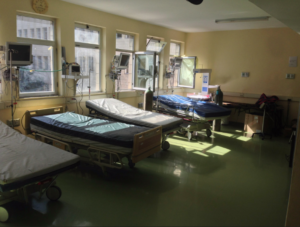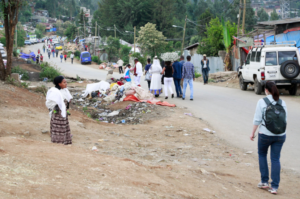Dr. Sophia Lane’s experience in Addis Ababa, Ethiopia
 In April of 2017 I travelled to Addis Ababa, Ethiopia as part of the Canadian Anesthesiologists’ Society International Education Foundation (CASIEF) partnership with the Toronto Addis Ababa Academic Collaboration (TAAAC). These organizations are partnered with the Tik ur Anbessa (Black Lion) Hospital in Addis to support a physician-anesthesiologist residency training program in teaching trips that are scheduled for 3 months per annum. There is a massive shortage of anesthesiologists in Ethiopia and thus an even greater scarcity of those with time to teach residents. I had been interested in participating in this initiative since my first year of residency and now, approaching the end of my 4th year, felt I was ready for the challenge of going to teach in an environment very different from the one I was training in. I suspected that in addition to teaching, I would also learn a lot about other ways to provide anesthesia, especially when resources are limited.
In April of 2017 I travelled to Addis Ababa, Ethiopia as part of the Canadian Anesthesiologists’ Society International Education Foundation (CASIEF) partnership with the Toronto Addis Ababa Academic Collaboration (TAAAC). These organizations are partnered with the Tik ur Anbessa (Black Lion) Hospital in Addis to support a physician-anesthesiologist residency training program in teaching trips that are scheduled for 3 months per annum. There is a massive shortage of anesthesiologists in Ethiopia and thus an even greater scarcity of those with time to teach residents. I had been interested in participating in this initiative since my first year of residency and now, approaching the end of my 4th year, felt I was ready for the challenge of going to teach in an environment very different from the one I was training in. I suspected that in addition to teaching, I would also learn a lot about other ways to provide anesthesia, especially when resources are limited.
Our trip was a 4-week mission for myself and Karim Mohamed, another 4th year resident, who is based in Ottawa. For the first 2 weeks we worked in the intensive care unit (ICU) with Neill Adhikari, an Intensivist from the University of Toronto associated with TAAAC. For the following 2 weeks we worked in the operating rooms (ORs) with Jason McVicar, a regional anesthesiologist associated with CASIEF from the University of Ottawa.
 My first memories of our trip are of walking the streets of Addis. Our daily trek to the hospital would take us along a busy main road crowded with a cacophony of people and cars. Blue mini-buses zip past, each with its own herald, shouting out its destination. A hodgepodge of shops line the streets, and a few beggars sit along the road. In some ways, this scene is reminiscent of downtown Toronto. I recall one woman sitting at a major intersection on a raggedy blanket. Her prosthetic leg sits upright in front of her, a silent behest.
My first memories of our trip are of walking the streets of Addis. Our daily trek to the hospital would take us along a busy main road crowded with a cacophony of people and cars. Blue mini-buses zip past, each with its own herald, shouting out its destination. A hodgepodge of shops line the streets, and a few beggars sit along the road. In some ways, this scene is reminiscent of downtown Toronto. I recall one woman sitting at a major intersection on a raggedy blanket. Her prosthetic leg sits upright in front of her, a silent behest.
We make our way down this street, picking our way toward the hospital. Half the sidewalks are being redone and there are piles of rubble everywhere, underlying red sand peeping through. The street is one of juxtaposition: there are massive glass-coated skyscrapers under construction with bamboo scaffolding lining their sides and workers buzzing about. From behind these gleaming new structures I catch glimpses of shacks patched together from concrete bricks and plastic cast-offs, without obvious electrical wiring or plumbing.
We climb a steep hill and the hospital comes into view. It too is under construction – older square buildings of concrete with many rowed square windows are being blended together with newer, lighter structures. The inside of the main wing we work in, which houses the ORs and the ICU, reminds me of Canadian schools built in the 1960s. Staircases are made of many-speckled stone steps with concrete landings, and the walls are painted a dull yellow. The ORs have been recently renovated – they are large and bright with big windows spanning the walls. The anesthetic machines are also new – Chinese-made and relatively familiar looking. The ICU has also recently been expanded – it consists of a surgical ICU staffed by an anesthesiologist and a medical ICU staffed by a respirologist-intensivist. The ICU has ventilators and a single (occasionally broken) x-ray machine, but no arterial-blood gas (ABG) analyzers or readily available infusion pumps.
 On our first day we met with our Ethiopian colleagues and further discussed the plan for the month. Our work would consist of a mix of didactic lessons, hands-on teaching sessions and clinical teaching via rounds in the ICU or time in the OR. The residents had a teaching schedule with pre-planned topics that they presented on that they wanted us to attend to help lead discussions on the presentation content after the talks. They also had a variety of topics they wanted us to give further lectures and practical sessions on, including regional anesthesia and the anesthetic gas machines.
On our first day we met with our Ethiopian colleagues and further discussed the plan for the month. Our work would consist of a mix of didactic lessons, hands-on teaching sessions and clinical teaching via rounds in the ICU or time in the OR. The residents had a teaching schedule with pre-planned topics that they presented on that they wanted us to attend to help lead discussions on the presentation content after the talks. They also had a variety of topics they wanted us to give further lectures and practical sessions on, including regional anesthesia and the anesthetic gas machines.
Our first 2 weeks in the ICU were an eye-opening experience for me. I constantly felt grateful for the tools and resources we had available to us in the ICUs I was used to working in at home. I also felt acutely aware of the amount of waste that occurred at home and learned a lot from the nurses working in the unit about resource allocation and protection. The denizens of the ICU were also very different than what I was used to: it was rare to meet a patient older than forty and many of the conditions we witnessed were ones that we either never saw in Canada or had progressed to a degree that would occur only rarely at home. I distinctly recall the young woman in fulminant heart failure because of the fatal combination of advanced rheumatic heart disease and pregnancy. Or the patient with intractable raised intracranial pressure who needed a correctly sized ventricular-peritoneal shunt. I also recall the challenge of diagnosing and treating what appeared to be severe acute respiratory distress syndrome (ARDS) using only lung ultrasound and a pulse oximeter. Our Ethiopian colleagues recognised and were frustrated by these resource limitations — and still cared for their patients with smart adaptations. We tried to focus our rounds on practical information in the context of their current working environment, while incorporating teaching on arriving technologies, such as interpreting ABGs (a blood gas machine was on order) or ultrasound-guided vascular access, as the unit had recently acquired an ultrasound machine. Meanwhile, in addition to teaching, Dr. Adhikari provided the residents with research studies that had been done in low and middle income countries (LMICs) which would be more relevant to their practice, rather than the ones that much of our practice at home was based on.
 I was continually impressed by the depth of general medical knowledge of the residents I met and the detail with which they researched the presentations they gave to their peers. The educational challenges facing the program were even greater than in previous years as the government had recently expand the residency program and doubled the number of residents it took on that year as compared to past years. While long term this strategy would increase access to anesthesiologist-provided care, in the short-term it was making it even more challenging to find adequate learning opportunities for all the new residents. The residents were acutely aware of this and keen to seize every opportunity – they reminded us more than once of sessions they felt were particularly important we cover in our month and stayed extra late when we did give a hands-on session on the anesthetic machines, asking astute questions and clarifying points of confusion. Similarly, the residents went through extra steps to arrange regional anesthesia practice when Dr. McVicar was there, given his expertise in the area. They sought out patients and trundled ultrasound machines from the main operating rooms to the separate orthopedic hospital. After performing blocks on patients, they stayed late to do further ultrasound practice on each other to reinforce the ultrasound anatomy.
I was continually impressed by the depth of general medical knowledge of the residents I met and the detail with which they researched the presentations they gave to their peers. The educational challenges facing the program were even greater than in previous years as the government had recently expand the residency program and doubled the number of residents it took on that year as compared to past years. While long term this strategy would increase access to anesthesiologist-provided care, in the short-term it was making it even more challenging to find adequate learning opportunities for all the new residents. The residents were acutely aware of this and keen to seize every opportunity – they reminded us more than once of sessions they felt were particularly important we cover in our month and stayed extra late when we did give a hands-on session on the anesthetic machines, asking astute questions and clarifying points of confusion. Similarly, the residents went through extra steps to arrange regional anesthesia practice when Dr. McVicar was there, given his expertise in the area. They sought out patients and trundled ultrasound machines from the main operating rooms to the separate orthopedic hospital. After performing blocks on patients, they stayed late to do further ultrasound practice on each other to reinforce the ultrasound anatomy.
Our time in Addis was busy and challenging, and just as we were getting used to the system, our month was coming to a close. In discussing with Karim, we found we would recommend certain things to others considering a trip, and that we ourselves plan to do when we return. Firstly, communication with the residents was often done through informal channels or via one of the staff. To ensure that all information is relayed, we would request an email list for the residents and communicate to the group directly that way. This would help eliminate some of the issues we had around scheduling teaching sessions and ensuring that everyone is aware of logistical details. Having this list in advance of our trip would also have allowed us to prepare teaching sessions that fit their learning needs, rather than assessing needs and preparing material as we went along. We would also liaise more closely with the administrative staff about the scheduling of teaching sessions as we often encountered room double-bookings and last-minute changes. Finally, creating a form of ‘handover’ between ourselves and the next group, either from Canada or another international partner involved in anesthesiology education (University of Bergen, Norway and Seattle Alliance Outreach) to ensure continuity and avoid overlap would help improve sustainability of our efforts. We felt very grateful to be able to participate in this initiative and get to know so many amazing people in Addis. We look forward to continuing our teaching efforts there!

